Medical Disclaimer: This article is for informational purposes only and does not substitute professional veterinary advice. If your dog shows signs of severe or persistent stress, consult a licensed veterinarian.
Table of Contents
Introduction
Have you ever looked at your dog and sensed something was off but couldn’t quite explain why? You’re not alone. Many pet owners struggle to recognize the subtle cues dogs use to express discomfort. Unlike humans, dogs can’t tell us how they feel, so we must learn to read their body language. Recognizing dog stress signs is a vital skill that can make a profound difference in your pet’s quality of life.
As a veterinarian in general practice, I’ve helped hundreds of owners identify and manage dog stress signs sometimes before they turn into serious behavior problems or health concerns. From a trembling tail to a tense jaw, these signs speak volumes about your dog’s emotional state. Understanding dog behavior begins with tuning into the nonverbal clues your dog gives every day.
In this guide, we’ll break down the most common dog stress signs, explore how to interpret them in context, and share simple, vet-approved ways to calm an anxious pup. Whether you’re raising a rambunctious puppy or caring for a senior dog, mastering dog body language will help you build a deeper, more trusting bond with your four-legged friend.
Key Takeaways: Dog Stress Signals at a Glance
- Dog stress signals are often subtle, including yawning, lip-licking, whale eye, and pacing.
- Context matters: panting could mean heat, not stress. Look for patterns and combinations.
- Dog body language varies by breed and personality know what’s normal for your pet.
- Chronic stress affects health and behavior. Dogs may mirror your stress levels.
- You can help by creating routines, safe spaces, and using positive reinforcement.
- Consult a vet or certified behaviorist if signs are frequent or escalate.
Knowing how to read dog stress signs gives you a powerful tool to prevent anxiety and nurture your dog’s well-being.
What Are Dog Stress Signs?
You Can Also Visit: https://doglifeexpert.com/avocado-oil-for-dogs-2025-best-vet-guide
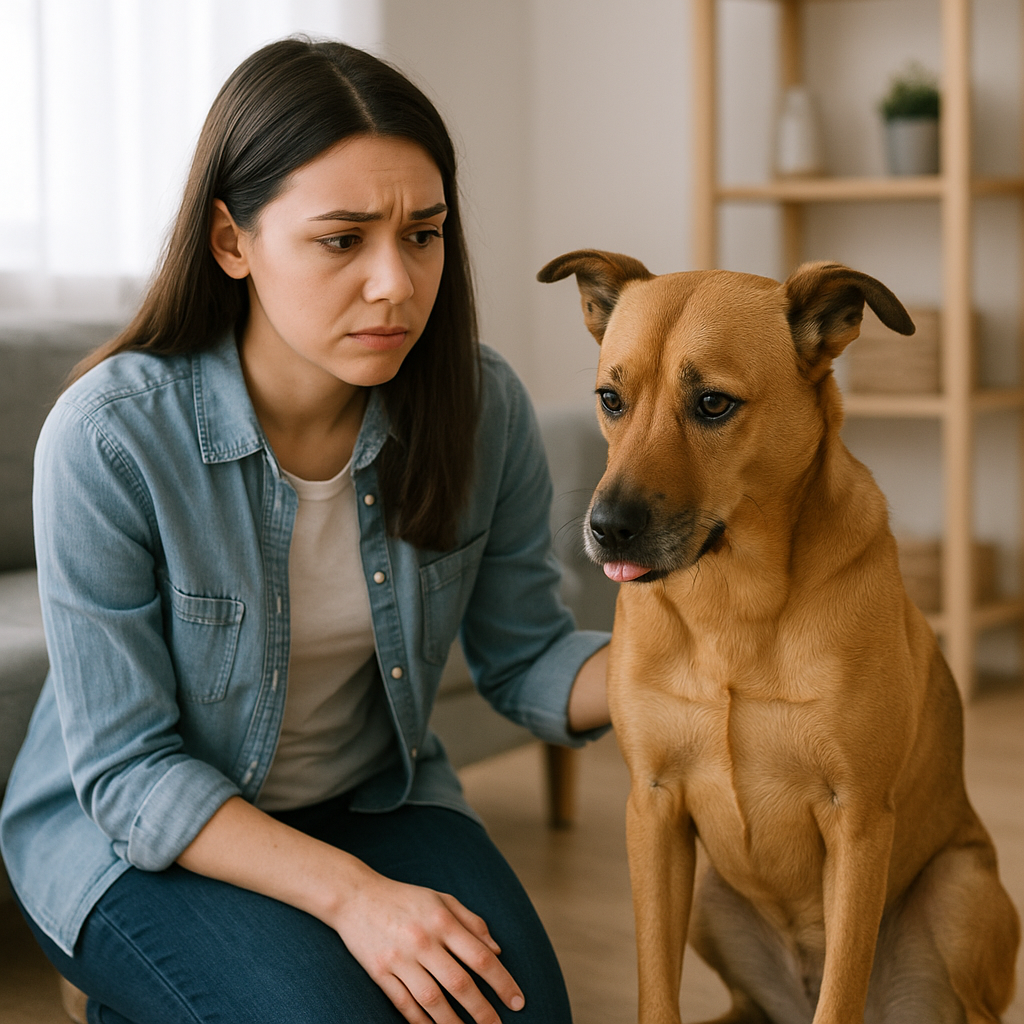
Understanding how dogs communicate is essential for early intervention and improving their quality of life. Dog stress signals are behavioral cues that indicate your dog may be feeling overwhelmed, anxious, or fearful. These signals range from obvious actions, like growling or whining, to subtle shifts in posture or eye movement.
Why Stress Happens in Dogs
Dogs experience stress just like humans triggered by environmental changes, lack of control, social conflict, or even our own emotional state. Common causes include:
- Loud noises (e.g., thunderstorms, fireworks)
- Unfamiliar people or animals
- Changes in routine or environment
- Separation from their owner
- Illness or pain
While short-term stress can be adaptive (like during a vet visit), chronic stress may lead to behavioral and physical health issues.
My Clinical Experience: How I Spot Stress in Practice
As a practicing veterinarian, I often see dog stress signs during physical exams especially with nervous rescues or puppies in new homes. One young Labrador I treated began panting and licking his lips repeatedly as I approached with a stethoscope. His tail was still wagging, but the lip-licking and widened eyes were clear signs of emotional discomfort. Recognizing those dog body language signals allowed us to pause, reward calm behavior, and continue more gently.
Stress vs. Normal Behavior – How to Tell the Difference
Context is key when interpreting dog stress signals. A panting dog in the sun may be hot, not anxious. A growl during tug-of-war can be playful, not threatening. This is why understanding dog behavior in different scenarios is so important.
Here’s a helpful rule: if you notice multiple stress signs occurring together like tucked ears, whale eye, and yawning it’s more likely your dog is genuinely distressed.
Common Signs of Stress in Dogs

Recognizing dog stress signals starts with observing changes in posture, expression, and behavior. Many signs can be misread as disobedience or even excitement but when interpreted correctly, they offer insight into your dog’s emotional state.
Facial & Eye Signals
These subtle expressions are often the first clues to your dog’s inner stress:
- Whale Eye: When the whites of the eyes are visible, often paired with a turned head. A classic sign of unease or wariness.
- Yawning: A stress yawn is slower and more exaggerated than a sleepy one. Dogs may yawn during tense moments, like grooming or noisy gatherings.
- Lip-Licking: Quick flicks of the tongue over the nose often signal discomfort, especially during social encounters.
- Tense or Pulled-Back Lips: This can look like a snarl but may simply show stress, not aggression.
Vocalizations & Sounds
Some dogs are more vocal when stressed. These dog stress signs are usually easy to hear but can still be misinterpreted:
- Growling: Not always a threat. It’s often a warning that your dog is uncomfortable and needs space.
- Whining: High-pitched vocalization that may mean frustration, anxiety, or physical discomfort.
- Barking: While barking has many meanings, repetitive or high-pitched barking may indicate anxiety.
Body Language & Movement
Many aspects of dog body language reveal stress through how they move or hold themselves:
- Tucked Tail or Flattened Ears: Indicates fear, submission, or discomfort.
- Raised Hackles: Hair standing up along the spine due to arousal, fear, or stress.
- Pacing: Repeated walking back and forth, often seen during thunderstorms or in new environments.
- Freezing: When a dog suddenly becomes still, it may be overwhelmed and unsure how to react.
Other Physical & Behavioural Changes
Some dog stress signs show up over time and may be mistaken for health problems:
- Excessive Panting: Especially in cool environments or without physical exertion.
- Avoidance Behaviors: Looking away, hiding, or turning their back can all indicate stress.
- Excessive Grooming: Licking paws or chewing fur to self-soothe.
- Loss of Appetite: Skipping meals or ignoring treats can indicate emotional or physical distress.
- Digestive Upset: Vomiting or diarrhea can occur during stressful events, like boarding or car rides.
Breed-Specific Considerations
Not all dog stress signals look the same across breeds:
- Huskies and Malamutes: Naturally curled tails can make stress harder to detect watch for stiffness or changes in position.
- Pugs and Bulldogs: Wide eyes and noisy breathing may obscure signs like whale eye or panting.
- German Shepherds: Their upright ears can seem alert even when they’re scared.
Health Warning Signs to Watch
Sometimes stress masks an underlying medical issue. Watch for:
- Limping
- Tense posture
- Head hanging
- Arched back
- Whimpering
- Excessive drooling or lip-smacking
If you see these alongside emotional dog stress signs, book a vet visit to rule out pain or illness.
5-Minute Home Stress Checklist
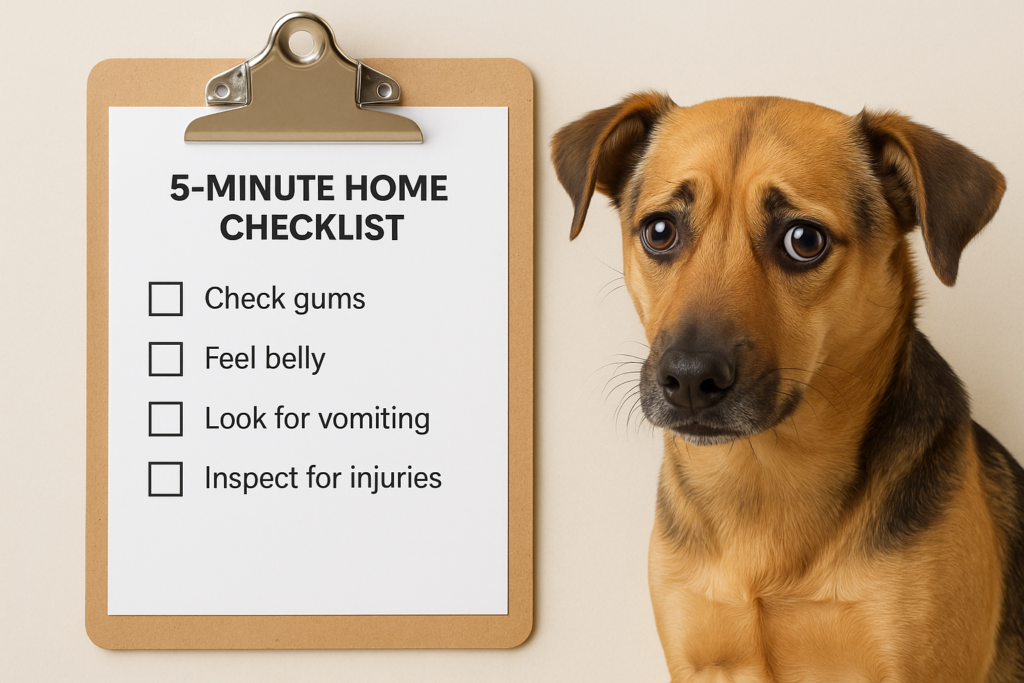
Sometimes you just need a quick gut-check to know whether your dog is stressed. Use this easy checklist to scan for dog stress signals in real time. If you answer “yes” to several of these, your dog may be experiencing emotional or physical stress.
At-Home Stress Checklist
- Is your dog panting excessively in a cool or calm environment?
- Have you noticed lip-licking, yawning, or whale eye in social situations?
- Is your dog hiding, freezing, or avoiding eye contact?
- Has your dog started whining, barking, or growling more than usual?
- Is your dog pacing, trembling, or acting restless at odd times?
- Have they shown a sudden loss of appetite even skipping favorite treats?
- Has grooming become excessive (e.g., licking paws until raw)?
- Is their tail tucked or body posture tense?
- Do they refuse to play or engage when they normally would?
- Do they show more signs of fear or aggression around other dogs or people?
If you marked several, it’s time to interpret the context and consider whether professional help is needed. Chronic or escalating dog stress signs may require a behaviorist or vet to rule out medical causes.
This checklist empowers you to take quick, informed action based on understanding dog behavior at home.
How Human Emotions Affect Dog Stress

Your mood might be rubbing off on your pup. Studies have shown that the emotional connection between dogs and their humans runs deep so much so that your stress can literally become their stress. Recognizing how your own behavior influences your dog is a vital part of understanding and managing dog stress signals.
The Science Behind Owner-Dog Stress Synchronization
A groundbreaking 2019 study published in Nature found that dogs and their owners share synchronized stress levels over time. Researchers measured hair cortisol concentrations (a stress hormone) in 58 dogs and their owners across different seasons. The results? Dogs mirrored their owners’ long-term stress levels especially if the dogs were female or participated in competitive activities with their humans (Nature, 2019).
This means that your emotional well-being isn’t just important for you it directly affects your dog’s stress and behavior.
Tips to Regulate Your Own Stress Around Pets
Because your stress can influence how your dog behaves, learning to stay calm benefits both of you. Here are ways to stay emotionally balanced and support your pup:
- Breathe Before You React: If your dog barks or growls, pause and breathe deeply before responding. Your calm response helps diffuse tension.
- Avoid Unpredictable Behavior: Sudden loud movements, yelling, or rushed actions can spike your dog’s anxiety.
- Stick to a Routine: A consistent schedule reassures your dog, even if your own day feels chaotic.
- Mindful Interactions: Speak in soothing tones, use gentle body language, and create peaceful shared activities like evening walks.
Just like your dog shows stress signs, so do you and they’re watching. Being aware of how your presence impacts your dog is a powerful step in understanding dog behavior and reducing overall household stress.
How to Help a Stressed Dog

Once you recognize dog stress signals, the next step is knowing how to respond. Whether your dog is pacing during storms or showing subtle signs like lip-licking at the vet, timely intervention can prevent their stress from escalating into anxiety or aggression. Below are practical strategies based on veterinary experience and behavior science.
1. Safe Spaces & Soothing Routines
Create an environment where your dog feels secure:
- Set up a cozy retreat (crate, playpen, or quiet room) with soft bedding and toys.
- Use white noise machines or calming music to block out stressors like fireworks.
- Stick to a daily routine for feeding, walking, and rest to provide predictability.
2. Enrichment & Exercise
Dogs need outlets for physical and mental energy. A bored or under-stimulated dog is more likely to display dog stress signs:
- Daily walks, off-leash play, or tug-of-war.
- Puzzle feeders, snuffle mats, or frozen Kong toys for mental stimulation.
- Scent games (like hide-and-seek with treats) activate calming brain chemistry.
3. Training & Calming Products
- Reinforce calm behavior with praise, treats, and affection.
- Use desensitization for known triggers like gradually exposing your dog to vacuum sounds or car rides.
- Try pheromone diffusers like Adaptil or anti-anxiety wraps (e.g., ThunderShirt) with veterinary guidance.
4. When to Call a Vet or Behaviourist
If dog stress signals are frequent, intense, or affecting daily life:
- Rule out pain, illness, or cognitive dysfunction (especially in senior dogs).
- Consult a certified behaviorist for a tailored behavior modification plan.
- Discuss medications if stress leads to self-harm or severe aggression.
5. Cost of Managing Canine Anxiety in Canada
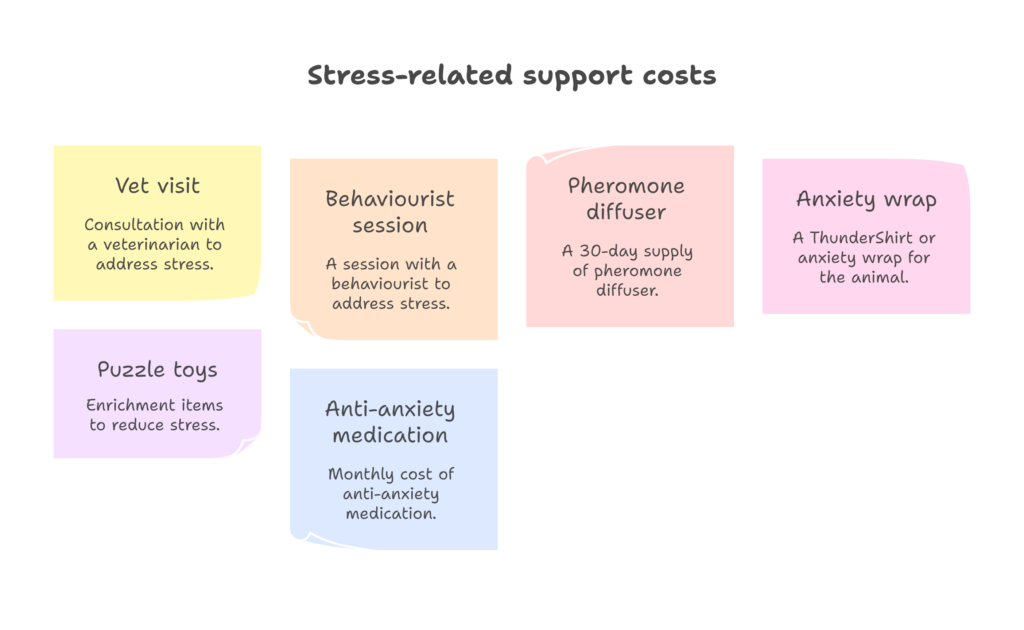
Investing in these resources supports not just symptom management but long-term emotional wellness.
Prevention Tips for Reducing Dog Stress
Preventing stress is often easier than managing it after the fact. By understanding the root causes of dog stress signals, you can proactively build a lifestyle that supports your dog’s emotional well-being.
Early Socialization
- Expose puppies to different sights, sounds, people, and textures early on. This helps reduce fear and uncertainty later in life.
- Use treats and praise to create positive associations with new experiences.
- Enroll in a puppy kindergarten class that emphasizes dog body language and safe play.
Predictable Routines
- Dogs thrive on consistency. Stick to a predictable daily rhythm for meals, walks, playtime, and bedtime.
- Sudden changes (like new work schedules or moving homes) can trigger dog stress signs ease transitions with gradual exposure and reassurance.
Gentle Exposure to Triggers
- Identify your dog’s triggers (e.g., vet visits, strangers, car rides) and gradually introduce them in low-stress ways.
- Use treats and calm voice tones to reinforce bravery and curiosity.
- Never force interactions respect avoidance as a form of communication.
Enrichment Every Day
- Enriching your dog’s world with variety helps them build confidence:
- Rotate toys weekly.
- Use food-dispensing puzzles.
- Explore new walking routes or hiking trails.
- Mental stimulation reduces anxiety, especially in high-energy breeds.
Monitor for Early Warning Signs
- Don’t wait for a full-blown meltdown to act. Subtle cues like avoidance, yawning, or licking lips are early dog stress signs.
- Keep a log if behaviors seem to escalate or cluster around certain events.
By embedding these habits into your routine, you’ll reduce the chances of chronic anxiety and build a stronger, more secure relationship. Prevention is the ultimate form of understanding dog behavior it shows your dog that their needs are seen, respected, and prioritized.
FAQs About Dog Stress
Pet owners often have specific questions about dog stress signals, especially when they’re trying to distinguish between normal behavior and signs of emotional distress. Here are some of the most common “People Also Ask” style questions with clear, vet-informed answers.
What’s the most overlooked sign of stress in dogs?
Answer: Lip-licking and yawning are frequently missed because they can seem normal. But when they appear during interactions or in unfamiliar environments, they may indicate early dog stress signs. Watch for combinations of subtle cues.
Can dogs die from too much stress?
Answer: While stress alone is unlikely to directly cause death, chronic stress can contribute to serious health problems such as weakened immunity, heart disease, or gastrointestinal issues. That’s why recognizing and managing dog stress signals is so important for long-term wellness.
Should I pet my dog when it’s stressed?
Answer: Yes, if your dog seeks comfort. Gentle petting and a calm voice can reduce anxiety. However, if your dog moves away, respect their space. Forcing contact can increase their stress. Let dog body language guide your response.
What’s a calming signal?
Answer: Calming signals are behaviors dogs use to de-escalate tension, like yawning, blinking, sniffing, or turning their head. They’re part of natural dog body language and often appear when a dog is unsure, scared, or overwhelmed.
Do dogs fake stress for attention?
Answer: Not quite. Dogs don’t fake emotions, but they may repeat behaviors that previously resulted in comfort or treats. If your dog shows dog stress signals only in specific contexts, it could be a learned response still worth addressing with consistency and routine.
These FAQs help clarify misconceptions and empower you with a more nuanced understanding of dog stress signs and emotional cues.
Conclusion: Know Your Dog, Reduce Their Stress
Mastering the art of reading dog stress signals is one of the most impactful things you can do as a pet owner. By tuning into their dog body language, you gain a window into your dog’s emotional world and that insight allows you to act early, prevent problems, and deepen your bond.
Whether it’s a trembling tail, a tense jaw, or a sudden yawn during chaos, every sign tells a story. The more fluent you become in understanding dog behavior, the more confidently and compassionately you can support your dog through life’s ups and downs.
Here’s what to remember:
- Stress is a normal part of life, but chronic stress isn’t.
- Dogs can’t speak, but their bodies and behaviors speak volumes.
- Your own emotional state affects theirs stay calm, create routines, and lead with empathy.
- Seek help when needed. A vet or behaviorist can offer clarity and relief.
Above all, recognize that each dog is unique. What frightens one may not faze another. By learning your dog’s baseline behaviors and observing changes with curiosity not frustration you create a foundation of trust and emotional safety.
Thank you for taking the time to learn how to recognize and respond to dog stress signals. Your dog may not say it, but their body will surely show it and now, you’ll know what it means.


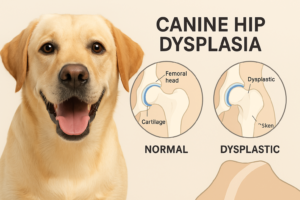

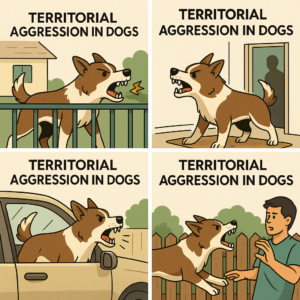
Pingback: Best Traditional Chinese Medicine for Dogs (2025 Guide to Holistic Care)
Pingback: Understanding Thunder Anxiety in Dogs 2025